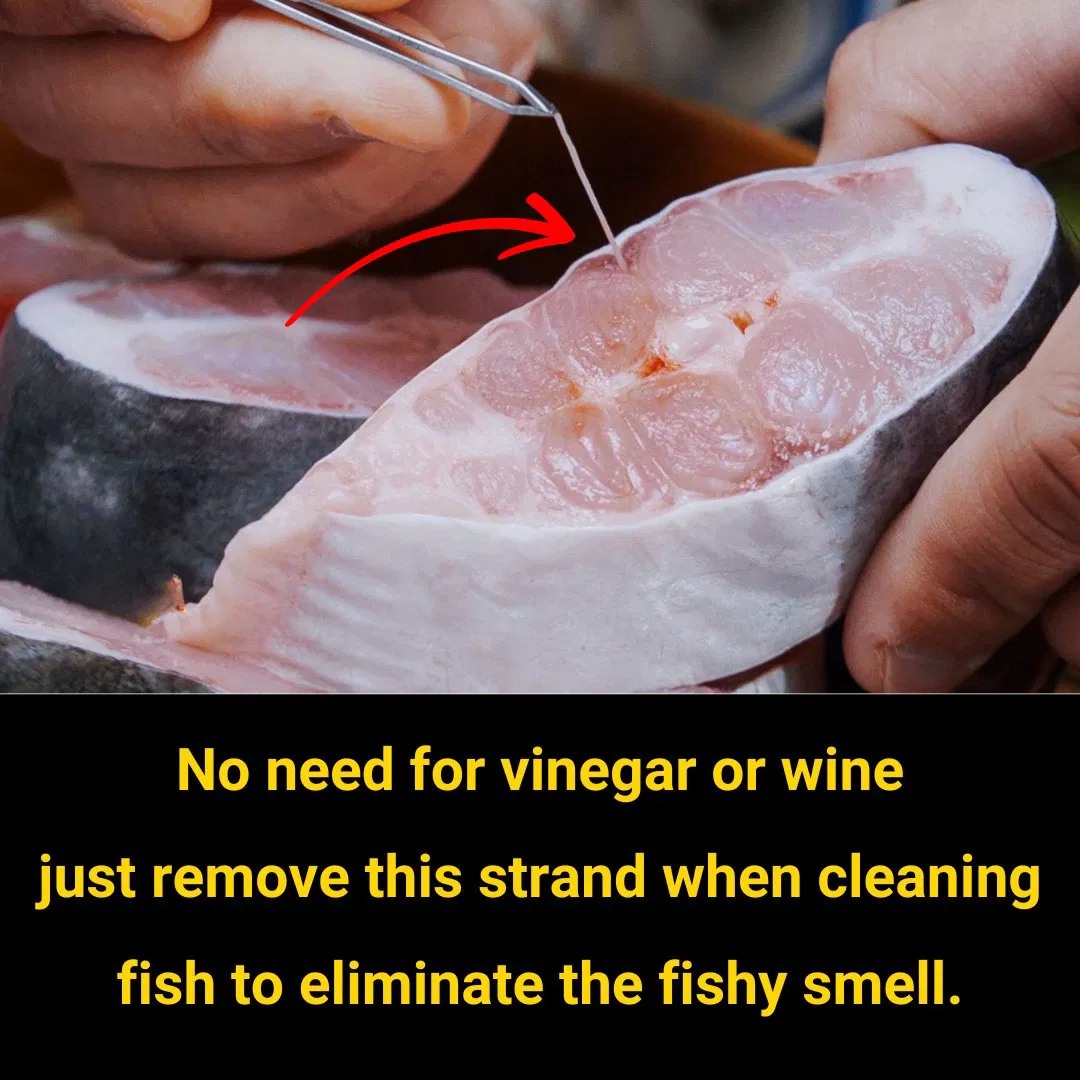When it comes to cooking fish, one of the biggest challenges many people face is dealing with its persistent fishy smell. Whether you’re preparing a delicate filet or a hearty fish stew, that unmistakable odor can sometimes overpower the dish. While most people rely on vinegar, lemon juice, or even alcohol to neutralize the smell, there’s a lesser-known technique that’s both simple and incredibly effective—and it doesn’t require any strong-smelling additives. The key? Removing the thin, white tendon that runs along the fish’s spine. This tiny, overlooked part of the fish plays a surprisingly big role in producing that fishy smell we all want to avoid.

The Science Behind the Fishy Odor
Fish naturally produce trimethylamine oxide (TMAO), a compound that breaks down into trimethylamine (TMA) after the fish is caught and starts to decay. This breakdown is what causes the distinct fishy odor. While washing fish in vinegar or alcohol can neutralize TMA, these methods sometimes alter the fish’s flavor or texture. However, one little-known culprit behind the smell is the white tendon located along the spine of certain fish, especially species like carp. Removing this tendon can significantly reduce the odor without requiring any chemical agents.
Identifying and Removing the White Tendon
When preparing fish, start by gutting and cleaning it thoroughly. After removing the guts and washing the cavity, place the fish on a clean cutting board. Use a sharp knife to make a shallow incision approximately one centimeter behind the fish’s head. Look closely along the spine, and you’ll notice a thin, white, thread-like tendon running parallel to the fish’s backbone. This tendon is often overlooked during cleaning, but it’s a major source of that lingering fishy smell.
To remove it, use your fingers, a pair of tweezers, or even small kitchen pliers. Carefully grip the tendon and pull it out slowly and steadily. Be cautious not to break it during the process, as leaving pieces of the tendon behind could compromise the results. Repeat the same process on the other side of the fish’s spine.
While this step might seem small or insignificant, it’s incredibly effective. By removing the tendon, you’ll notice a significant reduction in the fish’s odor. This technique works especially well with freshwater fish like carp, where the tendon is more prominent.
Why This Method Is Better Than Vinegar or Alcohol
Soaking fish in vinegar or alcohol is a common practice to reduce odor, but these methods can sometimes leave behind an unwanted aftertaste or even alter the fish’s natural texture. Vinegar, for example, can make fish slightly sour, while alcohol might not fully evaporate during the cooking process, leaving traces of its flavor in your final dish.
Removing the tendon, on the other hand, is a completely natural and additive-free method. It doesn’t affect the fish’s taste, texture, or nutritional value. The only thing it changes is the smell, which becomes noticeably cleaner and fresher. Plus, this technique requires no extra ingredients—just your hands, a knife, and a little bit of patience.
Additional Tips for Reducing Fish Odor
While removing the tendon is a game-changing trick, there are a few other simple steps you can follow to ensure your fish smells as fresh as possible:
- Use Fresh Fish: The fresher the fish, the less intense the smell. Whenever possible, purchase fish from a reputable supplier and cook it on the same day.
- Clean Thoroughly: Rinse the fish under cold running water to remove any blood, scales, or leftover internal residue.
- Use Salt Water: Briefly soaking fish in lightly salted water can also help neutralize some of the natural odor without altering the flavor.
- Dry Completely: Pat the fish dry with paper towels before cooking to prevent excess moisture from intensifying the smell during cooking.
Perfect for a Variety of Dishes
This tendon-removal method works well for all kinds of fish dishes, from grilled filets to hearty stews. Since the fish retains its natural flavor without interference from acidic or alcoholic additives, you’ll have more control over seasoning and marinades. Imagine cooking a beautiful pan-seared fish filet where the flavor shines through without being overshadowed by a lingering fishy odor—that’s the result you can expect when you incorporate this trick into your fish-preparation routine.
A Simple Trick for Better Meals
Cooking fish doesn’t have to involve battling stubborn odors. By simply removing the thin tendon along the spine, you can drastically reduce the smell and enhance the overall quality of your dish. It’s a technique that’s easy to master and requires no special tools or ingredients. Once you try it, you’ll wonder why you didn’t know about it sooner.
This method is particularly helpful for those who love cooking fish at home but dislike the lingering smell in their kitchen. It’s also a great tip for anyone who wants to prepare fish dishes that retain their clean, fresh flavor without being masked by acidic additives like vinegar or lemon juice.
Final Thoughts
Eliminating fish odor doesn’t have to be complicated or involve overpowering ingredients. Removing the white tendon along the fish’s spine is a quick, effective, and natural solution that delivers impressive results. Not only does it make cooking and eating fish more enjoyable, but it also allows the true flavor of the fish to shine through in every bite.
The next time you prepare fish, take an extra moment to locate and remove this overlooked tendon. It’s a small step that makes a world of difference. With this simple trick in your cooking arsenal, you’ll never have to worry about overpowering fish odors again. Enjoy your meal, savor the flavor, and impress your family with fresher, cleaner-tasting fish dishes every time!





